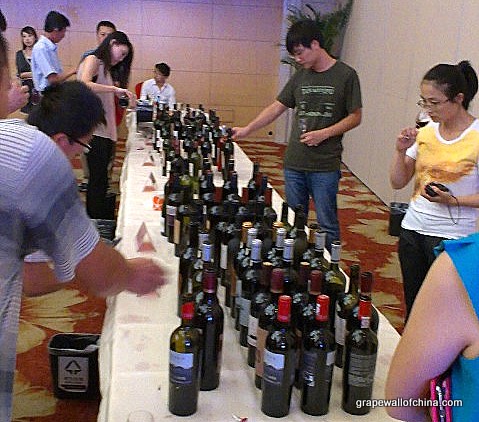~
By Jim Boyce
Media company Wine China and cork supplier Columbin recently held a tasting of ~30 Chinese wines, most of them regional brands unknown to the general consumer in Beijing. Jim Sun of Wine China asked me to talk for a few minutes to the attendees, most of them wine makers with the brands participating. I made five brief points from my perspective as a consumer and thought I would share them here. (As I didn’t write them down, the following isn’t verbatim, but gives the basic points.)
1. The region of Ningxia is winning the China wine game at this point and is unique in having a cluster of over a dozen decent producers. Good natural conditions and strong government support are two key reasons. Another is the availability of large tracts of land that allow wineries to better control fruit quality as compared to buying from many small-scale farms.
2. The quality of Chinese wines is improving. I started drinking them eight years ago and finding a handful of good ones then was a challenge. Today I can easily create a “top 10†or “top 20†and point to a good number of decent producers. These good wines still represent a few cases of the total barrel of production in China but it shows what is possible with an increased focus on quality. This quality can be further raised, especially by better vineyard practices that give winemakers better grapes. But there are two key challenges when it comes to the consumer market.
3. One challenge is distribution. Better Chinese wines are often hard to find. Last year, I helped organize the Ningxia Wine Challenge in Yinchuan. We had 39 wines and the judges, led by Ma Huiqin and Jancis Robinson, deemed the vast majority as good. A few weeks later, I went to a supermarket in downtown Yinchuan, the capital of Ningxia, to grab a few of these wines to take to Beijing. I couldn’t find any of them. I have also had readers call me during trips to Yinchuan to ask where they can buy the wines I write about on this blog. It’s hard to explain that I don’t know where in Ningxia to get the best Ningxia wines.
Most of the best wines are also made in small quantities. If a winery only makes 10,000 bottles of a given label, that works out to one bottle per 130,000 people, not exactly something most drinkers can find and try.
4. The second problem is the prices. They are too high. I can walk into my local 7-ELEVEN and buy a decent bottle of Chilean wine for rmb75. All of the bottles at the Wine China-Columbin tasting cost more than this, with most between rmb250 and rmb900. They can’t compete in terms of value, at either the low end or high end, since wines from France, Spain, Australia and elsewhere offer more.
This especially matters now as government austerity measures are severely curtailing spending by officials, traditionally a key source of revenue. We do see increased spending by consumers, but while this group has traditionally bought wine for reasons of status (gifts and celebrations) or health, it is more and more buying them based on taste. Thus producers are looking at pressure to simultaneously raise quality and lower prices.
5. These are “good†problems. We are talking about the need for better distribution and pricing because these wineries are making something of value. We know China can make decent wines. What we don’t know is how many producers can provide greater value, either by improving quality or lowering price or both, and how many of them can get those bottles into the hands of consumers. These are intriguing questions as the wine market develops.
Grape Wall has no sponsors of advertisers: if you find the content and projects like World Marselan Day worthwhile, please help cover the costs via PayPal, WeChat or Alipay.
Sign up for the free Grape Wall newsletter here. Follow Grape Wall on LinkedIn, Instagram, Facebook and Twitter. And contact Grape Wall via grapewallofchina (at) gmail.com.


Leave a Reply
You must be logged in to post a comment.